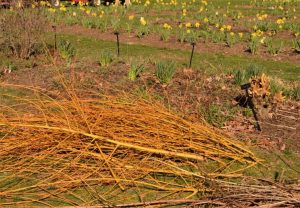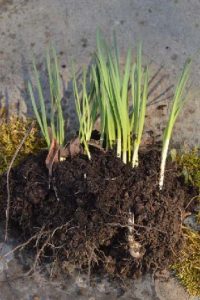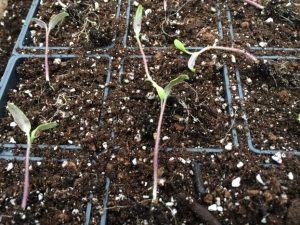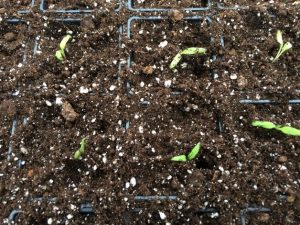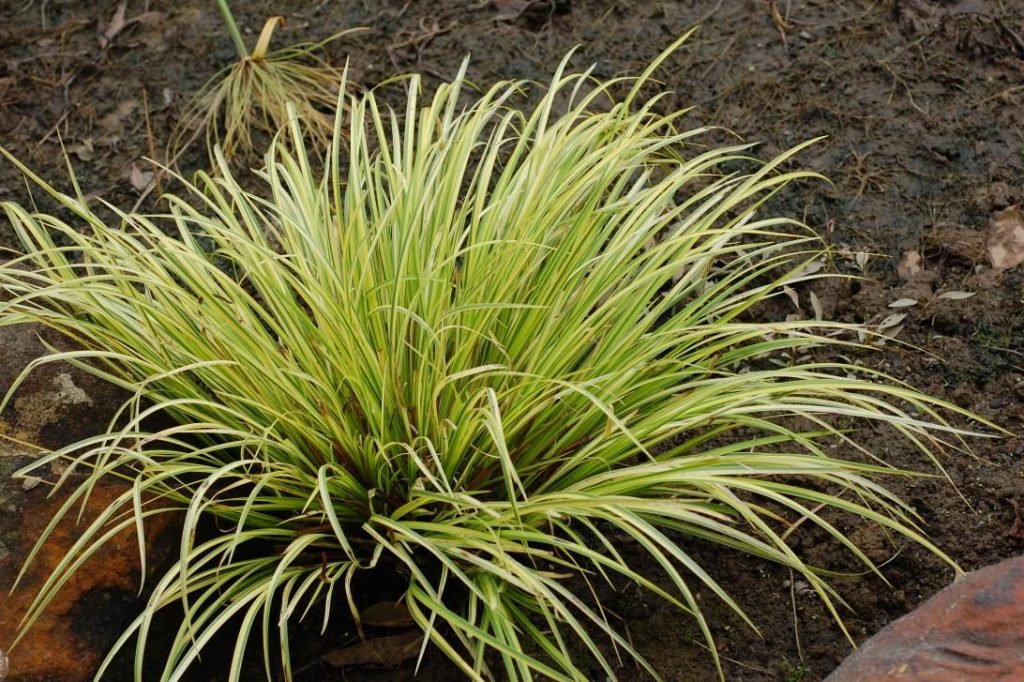As we experienced a year ago, the act of getting out into your Garden continues to be a great option as many of us continue to work at home. Plants continue to display their beauty and working in the soil and seeing things grow is a very calming. This will probably be a year that many homeowners continue to grow their own vegetables, and the garden retains its importance to many home gardeners. As the sun and warmth of April unfold, take a deep breath and prioritize what must be completed vs. what could be postponed for a day or two. Remember, gardening is our hobby and we do not need any more pressures or deadlines in our life!
Things to do:
- Finish pruning roses, small trees, and coppiced shrubs early in the month. Techniques for pruning red and golden-stemmed dogwoods (Cornus sanguinea cultivars) and willows (Salix), depends upon the deer browse pressure. Either ⅓ to ½ of the older stems can be cut back to 6-12” or the entire plant can be cut to that height as seen in the image below of a Red Stemmed Willow (the pruned plant is at the right of the image). Leaving some of the existing stems helps protect the young shoots from deer predation. Shrub roses can be cut in half to prevent them from becoming overgrown, while the stems of hybrid tea roses should be cut down about 2/3’s to a bud that is facing outward. Hydrangea arborescens cultivars can be cut back to 3”; Hydrangea paniculata cultivars can either be cut back severely to 12” or pruned lightly, leaving a 3-4’ tall framework for new growth to emerge; Hydrangea macrophylla should be thinned with the oldest and most branched stems cut to the ground while Hydrangea quercifolia should simply be lightly shaped.
- For ornamental flowering trees, thin out any water sprouts or ‘suckers’ that appear on branches that will grow into and become abrasive to existing branches above. Branches that rub against each other damage the bark and allow air and decay to impact the branches.
- Finish cutting back ornamental grasses and perennials.
- If you overwintered bananas outside (such as Musa basjoo), remove the insulating leaves and the surrounding wire cage.
- Divide grasses and perennials if necessary. Remember that the center portion of the plant is the oldest and least vigorous and should be discarded. The outer, more vigorous ring will yield at least 10 new plants, with 9 of those going to friends, a new garden, or a curbside sale!
- As soon as the early blooming bulbs (such as Snowdrops, Winter Aconites, Snowflakes and Scilla) have finished blooming, the clumps can be dug, divided and moved about the garden if so wished. These bulbs are much more successfully spread about in spring while still actively growing than when purchased as dormant bulbs in autumn. It is also financially more prudent!
- If your Narcissus have stopped blooming, they may be planted too shallow or are in need of division. Plants can be dug, divided and replanted while in leaf, as seen at left.
- Continue potting up Canna, Banana, Alocasia and other tropical plants that were overwintered in the basement. Make certain to test the tubers to ensure they have no soft spots or decay
- Edge bedlines and compost the pieces of turf that have been removed.
- Finish thatching and raking lawns. Apply a pre-emergent crabgrass control to established lawns before or during Forsythia bloom, if crabgrass was a severe problem in 2020.
- Apply fertilizer and lime to lawns and Vegetable Gardens as prescribed by soil test results.
- Apply corn meal gluten to flower beds as a weed pre-emergent and mild fertilizer as an organic alternative.
- For the Vegetable Garden, finish sowing tomato, pepper, and eggplant seeds. Earlier seeded Lettuce, Swiss chard, broccoli and cabbage seedlings can now be planted outside, especially under low tunnels or in containers. Many new gardeners do not realize how many vegetables can be grown on a sunny deck in a container! For tomatoes, if you sowed your seed in a tray and the first leaves or Cotyledons are now well developed, tease apart the seedlings and install the plants in individual cells. Tomato seedlings can be planted deep, since roots will develop along the entire stem, providing a stout and strong plant (see images above –planted too shallow on the left, planted to the proper depth on the right).
- Resist the urge to turn over or work the soil of your vegetable garden if the soil is too moist. In fact, try not to even walk on the soil if possible. If you can make baseballs from the soil, it needs a few more days to drain.
- It is best to actually put a soil fork into the ground and rock it back and forth to loosen the soil, vs rototilling. Breaking apart the soil damages soil borne mycorrhizae, which in turn enhance the growth of your vegetables!
- Early in April for those in Southern locations, later for those more Northern areas, seed can be sown directly in the garden for Beets, Carrots, Spinach, Cilantro, Lettuce, Arugula, Mustard Greens, Bok Choy, Peas and Turnips.
- It is time to plant potatoes, as they are typically planted 2-3 weeks prior to the frost free date (May 15 in central NJ). Only use ‘seed’ potatoes from a seed company and resist using potatoes that you have bought at a grocery store that are sprouting!
- Remove the wintergreens from containers and plant bulbs, pansies, primroses, evergreen grasses, etc for early spring color. Consider using the grassy foliage of Acorus gramineus ‘Ogon’, the Golden Sweet Flag pictured below, as a chartreuse accent plant for spring containers! Also consider many varieties of Lettuce and Swiss Chard, as they are also very attractive and mix well with Pansies and Primroses. Plus, you can harvest a meal right from your containers!
